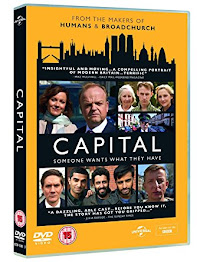Capital: Case study blog tasks
Reviews and features
Read the following review and feature on Capital:
Guardian review by Sam Wollaston
London Evening Standard: five things you need to know about Capital
1) What positive points does the review pick out about Capital? What criticisms are made - either of the TV drama or the original novel?
2) What references can you find in the reviews and feature to the idea Capital is a 'state-of-the-nation' drama? How does it capture modern-day London?
Watch the trailer for Capital:Capitol trailer
2) How does the trailer introduce the different narrative strands suggesting tension or enigma in the 40-second running time?

Capital offers a range of fascinating representations - from London and asylum seekers to capitalism and inequality. You need to be able to confidently discuss these issues in the context of 2015 London - with reference to key scenes from episode 1. Representations include: London, family, gender, ethnicity, religion, immigration, asylum, inequality, wealth, capitalism, aging and more.
1) Write an analysis of the representations in each of the key scenes from episode 1 we studied in the lesson:
Scene 1: opening sequence 00:30 – 4.49
Diversity of London - importance of immigration to London’s recent history
Conventional representation of a British family life - working class / lower-middle class.
“Not real millionaires” - does house value actually = wealth?
Gentrification of London.
Eastern European immigration is shown in the opening scene when the builders walk past (also represented by the skip outside house for funeral
Lack of representation of women in the financial services workplace/environment.
The conversation in Roger’s boss’s office is between three white men.
Fast-paced editing emphasises the pace and excitement of London and working in London.
‘Under-the-armpit’ shot on the underground train emphasises the reality of commuting and working in such a busy, bustling city.
Roger’s boss is German - another aspect of London immigration in 2015 (Europeans moving to London to take high-paying jobs in financial services).
“Bonus season” - and £75m profit - emphasises the crazy money in banking and therefore the inequality at the heart of London.
Scene 3: “Which of those isn’t absolutely essential?” 14.00 – 15.35
Traditional gender stereotypes and family set up - Roger is main breadwinner, Arabella talking about how to spend the money.
“Now I’m no feminist…”
“You’d be surprised at how little £1m covers these days.” Shows how privileged the richest Londoners are.
“Name one of those things that isn’t absolutely essential.”
“Maybe we should get Pinker Lloyd to pay Bogdan my bonus directly…"
Sound bridge while walking to church.
Use of audio codes when Quentina is getting ready for work. So much noise that Quentina needs to put up with - loud music, baby crying, loud phone conversation, train going past.
Black female lawyer - representation subverts usual picture of lawyers in media.
Why do people come to London - Quentina in contrast to Lothar. She is just trying to survive “If I go home I will be killed”
Scene 5: “What use is 30 grand?” 36.40 – 39.00
Drone shots of London - financial district.
Editing - sped up commute to show Roger’s disorientation and losing touch with reality
Roger completely destroyed by 30 grand bonus shows his white privilege laid bare.
“This isn’t how it works”
“There is a context to this… Swiss subsidiary” - shows global nature of finance industry / global capitalism.
Contrast with Quentina: “This is fundamentally not fair”.
Scene 6: life at the corner shop 40.10 – 42.55
Scene with Arabella in corner shop - clear she has never been in that shop before, Ahmed doesn’t realise she lives in same street. Shows disconnect in London.
Mise-en-scene of the dinner table scene - Kamal family all packed around a small dinner table and also including their mother in Pakistan using a video call. In contrast, we never see Roger’s family around a dinner table.
Working class values of community play against upper/middle class values of materialism.
2) How does Capital use stereotypes? Do the characters and issues represented in Capital reinforce or subvert the stereotypes we typically see in the media?
Capital was produced by independent production company Kudos for the BBC. Look at the Kudos website and also read the Kudos Wikipedia page.
1) Who is the parent company for Kudos? What changes of ownership have there been for Kudos? This is an example of conglomerate ownership.
Shine Group(2007-2015), Endemol Shine Group (2015-2018) , Banijay UK Products(2018- present)
2) Watch the showreel on the Kudos website. What other TV dramas have Kudos produced and for which channels? What awards have they won?
Comments
Post a Comment